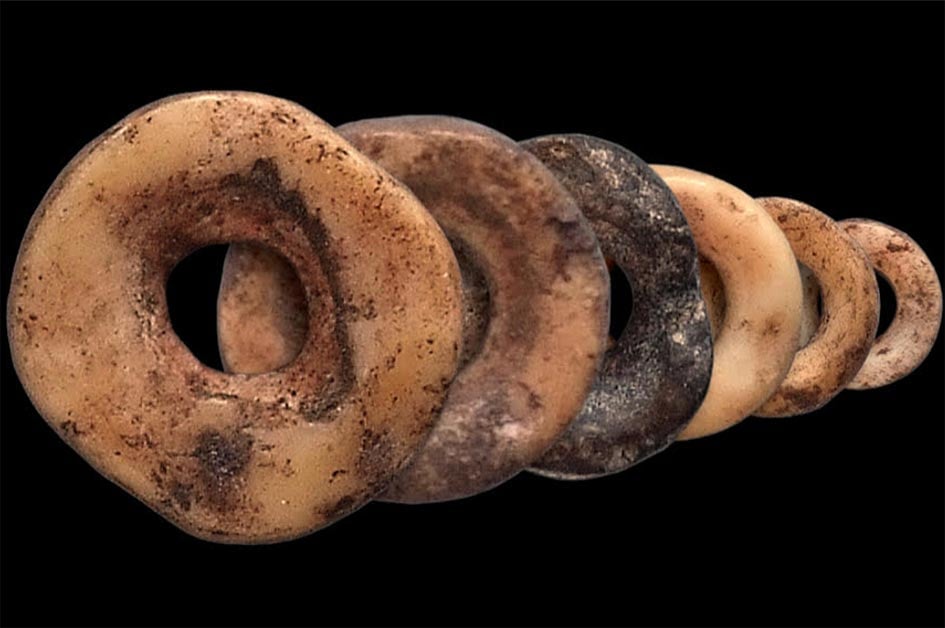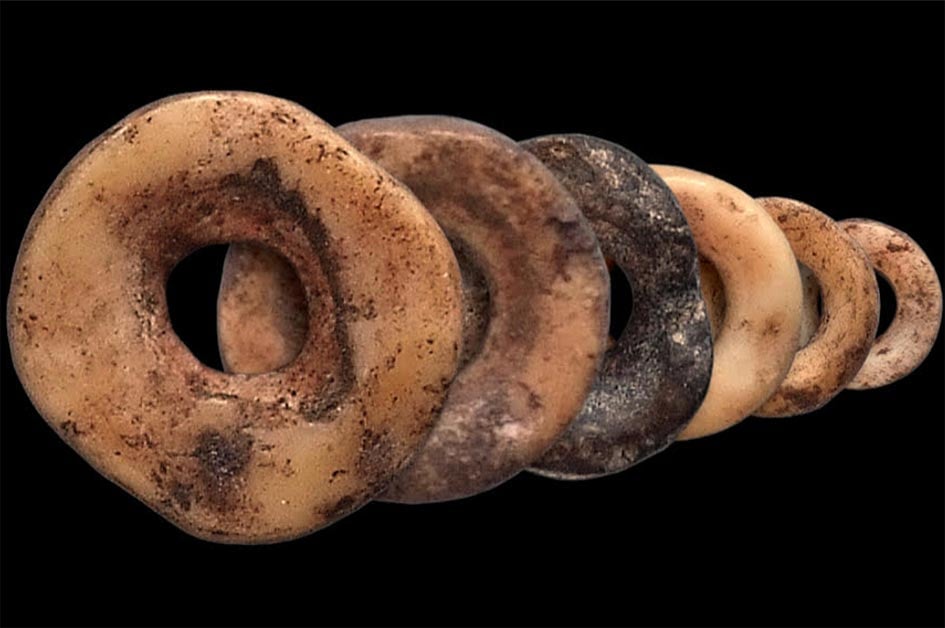

A team of scientists have discovered 33,000-year-old ostrich egg beads in the Lesotho Highlands, about a 1,000 kilometers away from where ostriches roamed. This establishes hitherto unknown prehistoric cultural exchange networks.
About 33,000 years ago, an ostrich in southern Africa’s Karoo Desert had its lunch of sweet grasses and flowers, then it laid an egg. Later that same night, the egg was lifted by a hunter-gatherer and after it was eaten, pieces of shell were drilled with holes and threaded onto an animal sinew cord and worn as a decorative string of beads. But this particular item of ancient jewelry travelled far to the east of where it was crafted and became treasured by a distant hunter-gatherer group living high in the eastern mountains.

Ostrich eggshell beads have been used to cement relationships in Africa for more than 30,000 years. (John Klausmeyer, Yuchao Zhao & Brian Stewart / University of Michigan)
Pushing Back Prehistoric Exchanges
Now, 33,000 years after that ostrich egg was laid, stolen, crafted and exchanged, a University of Michigan study published in the Proceedings of the National Academy of Science by paleolithic archaeologist Brian Stewart and colleagues, details the discovery of the beads in what is now Lesotho. Stewart is assistant professor of anthropology and assistant curator of the U-M Museum of Anthropological Archaeology, and his new paper provides evidence not only for “where” these beads were made, but also for “how long” hunter-gatherers used such things as a kind of “social currency.”
It was by measuring the atomic structure of the beads that details of the exchanging of these ornaments, over such long distances, were shown to have spanned much deeper into prehistory than previously thought. In the new study, which is available to read on PNAS, Stewart said “humans are just outlandishly social animals, and that goes back to these deep forces that selected for maximizing information, information that would have been useful for living in a hunter-gatherer society 30,000 years ago and earlier.”

Archaeologists work at rock shelters at Sehonghong and Melikane in southern Africa. (Brian Stewart / University of Michigan)
A Small Territory at a High Altitude
Lesotho is a small, high-altitude country consisting of a matrix of rivers cutting across dramatic mountain ranges, including the 3,482m (11,424 feet)-high peak of Thabana Ntlenyana. This landlocked kingdom is encircled by South Africa, and it has the highest average elevation in the African continent. Stewart said it would have been “a formidable place for hunter-gatherers to live.” However, the quantities of fresh water coursing through the country and its “belts of resources, stratified by the region’s elevation,” served as protection against climate and environmental changes for those who hunted there from as early “as 85,000 years ago,” according to the study.
Ostrich eggshell beads, and the jewelry items made from them, according to Stewart, are “Stone Age versions of Facebook or Twitter likes,” in that they affirm connections with exchange partners and alert other groups to the status of those relationships. Anthropologists know that contemporary hunter-gatherers used ostrich eggshell beads as offerings to establish and cement relationships with other groups, and in Lesotho, archaeologists have found small ornaments made of ostrich eggshell, but no evidence exists of those ornaments having been made there.

Archaeologists work at rock shelters at Sehonghong and Melikane in southern Africa. (Brian Stewart / University of Michigan)
Tracking the Ostrich Beads Origins
Finding eggshell beads “without” any evidence of production, the researchers ‘assumed’ that they had got to Lesotho through ancient exchange networks and testing their ‘suspicions’, the beads were examined using strontium isotope analysis. What this means is that the eggshell composition was analyzed to determine what and where the creature had been eating.
When animals graze strontium isotopes are absorbed into their tissues, and in this case in an eggshell, and Lesotho is situated in the Karoo Supergroup, which was created by relatively recent volcanic eruptions that formed the Lesotho Highlands. The researchers measured how much strontium was available in vegetation and soil samples, as well as rodent tooth enamel samples from museum specimens collected from across Lesotho and surrounding areas. They discovered that nearly 80% of the beads “could not” have originated from ostriches living near the highlands where the beads were found.

Archaeologists work at rock shelters at Sehonghong and Melikane in southern Africa. (Brian Stewart / University of Michigan)
You Show Us Yours, and We’ll Show You Ours
The egg matched the strontium found in much older sedimentary rocks that surround the supergroup, the outermost ring of which is 325 (201 mi) and 1,000 (621 mi) kilometers away from the Lesotho sites, determining that the beads were exchanged during climactic upheaval, “about 59 to 25 thousand years ago.”
Around 50,000 years ago, according to Stewart, the climate was going through “enormous swings” and he thinks it might be no coincidence that that’s when this type of technology began. He thinks this exchange network was perhaps used for transferring “information” about the whereabouts of natural resources, the conditions of landscapes, animals, plant foods and other people, and perhaps for securing “marriage partners.”
Essentially, these ancient ostrich beads establish that relationships developed between hunter-gatherer groups, ensured shared resources, so that when one region’s climatology turned bad, they could lean on the other’s stock pots.